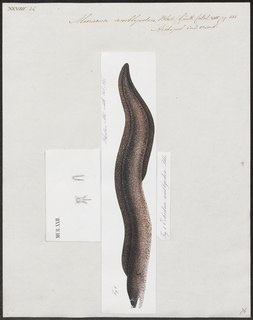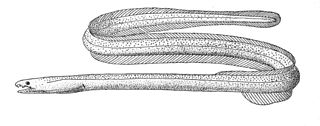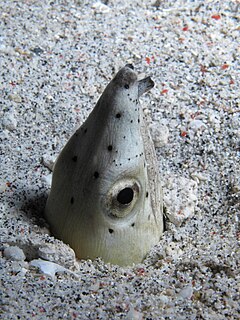
Echidna amblyodon, the Sulawesi moray is a moray eel found in the western central Pacific Ocean. It was described by Bleeker in 1856, originally under the genus Muraena. It is a marine, tropical eel which is known from Indonesia, in the western central Pacific Ocean. Males can reach a maximum total length of 20.5 centimetres (8.1 in).

Ophichthus is a genus of eels in the snake eel family Ophichthidae.
The sea conger, also known as the big-eye conger, is an eel in the family Congridae. It was described by Pieter Bleeker in 1853, originally under the genus Conger. It is a tropical, marine eel which is known from the western Pacific Ocean, including Kanagawa Prefecture, Japan; the eastern China Sea, and the East Indies. It leads a benthic lifestyle and dwells in sand and mud. Males can reach a maximum total length of 51 centimetres.
The Indian pike conger is an eel in the family Muraenesocidae. It was described by Pieter Bleeker in 1853. It is a marine, tropical eel which is known from the Indo-Western Pacific, including Somalia, India, Sri Lanka, Indonesia, the Philippines, Hong Kong and Taiwan. It dwells at a depth range of 800 to 875 metres, and inhabits soft sediments in coastal waters and estuaries. Males can reach a maximum total length of 250 centimetres (98 in), but more commonly reach a TL of 180 centimetres (71 in).

Muraenichthys gymnopterus is an eel in the family Ophichthidae. It was described by Pieter Bleeker in 1853, originally under the genus Muraena. It is a marine, tropical eel which is known from the western Pacific Ocean, including China, Indonesia, and India. It inhabits rocky reefs in shallow, warm seas. Males can reach a maximum total length of 30 centimetres (12 in).
The Indo-Pacific slender worm-eel is an eel in the family Ophichthidae. It was described by Pieter Bleeker in 1857. It is a marine, tropical eel which is known from the Indo-Pacific, including the Red Sea, East Africa, the Line Islands, the Society Islands, Johnston Island, Japan, Rapa Iti, Micronesia, and the southern Great Barrier Reef. It forms burrows in inshore sediments of loose gravel and sand. Males can reach a maximum total length of 38 centimetres (15 in).

The highfin snake eel (Ophichthus altipennis, also known as the blackfin snake eel or the black-finned snake eel, is an eel in the family Ophichthidae. It was described by Johann Jakob Kaup in 1856, originally under the genus Microdonophis. It is a marine, tropical eel known from the eastern Indian Ocean and northwestern and western central Pacific Ocean, including Australia, French Polynesia, Indonesia, Japan, the Marshall Islands, Malaysia, the Philippines, and Papua New Guinea. It dwells at a depth range of 0 to 40 m, and forms burrows in soft inshore sand sediments. Males can reach a maximum total length of 103 cm.

The Napoleon snake eel is an eel in the family Ophichthidae. It was described by Johann Jakob Kaup in 1856, originally under the genus Poecilocephalus. It is a marine, tropical eel which is known from the Indo-Pacific, including Durban, South Africa, Mauritius, Indonesia, Japan, Australia, and the Penghu Islands. It is known to dwell at a depth of 20 metres (66 ft), and inhabits lagoons and reefs; it forms solitary burrows in sand sediments. Males can reach a maximum total length of 75 centimetres (30 in).
Ophichthus brasiliensis is an eel in the family Ophichthidae. It was described by Johann Jakob Kaup in 1856, originally under the genus Centrurophis. It is a marine, tropical eel which is known from Brazil, in the southwestern Atlantic Ocean.

The dark-shouldered snake eel is an eel in the family Ophichthidae. It was described by Pieter Bleeker in 1864. It is a tropical, marine eel which is known from the Pacific Ocean, including the East Indies, the Society Islands, the Mariana Islands, Queensland, the Marshall Islands, Micronesia, Japan, and India. It dwells at a depth range of 2–15 metres, and inhabits reefs. It forms burrows in mud and sand, and forages during the night. Males can reach a maximum total length of 115 centimetres.
The death-banded snake-eel is an eel in the family Ophichthidae. It was described by Samuel Garman in 1899. It is a tropical, marine eel which is known from the eastern central and southeastern Pacific Ocean, including the central Gulf of California, Colombia, Costa Rica, Mexico and Panama. It dwells at a depth range of 35–760 metres, and forms burrows in sandy and muddy bottoms. Males can reach a maximum total length of 86 centimetres.
The Bigfin snake eel is an eel in the family Ophichthidae. It was described by Pieter Bleeker in 1853. It is a tropical, marine eel which is known from the Indo-Pacific. It dwells at a depth range of 0–25 metres, and inhabits sand and mud. Males can reach a maximum total length of 92 centimetres.

The many-eyed snake-eel is a species of eel in the family Ophichthidae. It was described by Pieter Bleeker in 1864. It is a tropical, marine and freshwater-dwelling eel which is known from the Indo-Pacific, including East Africa and the Hawaiian Islands. It dwells at a depth of 2 to 25 metres, and inhabits sand and rubble sediments near coral reefs. Males can reach a total length of 62.5 centimetres (24.6 in).
The rufus snake-eel is an eel in the family Ophichthidae. It was described by Constantine Samuel Rafinesque in 1810, originally under the genus Echelus. It is a marine, subtropical eel which is known from throughout the Mediterranean and the Black Sea, in the northeastern Atlantic Ocean, including Algeria, Albania, Croatia, Egypt, France, Cyprus, Gibraltar, Greece, Italy, Israel, Montenegro, Lebanon, Libya, Malta, Morocco, Monaco, Slovenia, Spain, Tunisia, the Syrian Arab Republic, and Turkey. It inhabits mud sediments on the continental shelf. Males can reach a maximum total length of 60 centimetres (24 in).
The olive snake eel is an eel in the family Ophichthidae. It was described by Pieter Bleeker in 1853, originally under the genus Ophisurus. It is a marine, tropical eel which is known from the Indo-Pacific. It forms burrows in soft sediments in shallow waters, and leads a nocturnal lifestyle. Males can reach a maximum total length of 95 centimetres (37 in).
Ophichthus singapurensis is an eel in the family Ophichthidae. It was described by Pieter Bleeker in either 1864 or 1865. It is a marine, tropical eel which is known from the western Pacific Ocean.
The Antillian snake eel is an eel in the family Ophichthidae. It was described by John Roxborough Norman in 1922. It is a marine, deep water-dwelling eel which is known from the western central Atlantic Ocean, including Cuba, Puerto Rico, Trinidad-Tobago, and Venezuela. It is known to dwell at a maximum depth of 300 meters, and inhabits coastal waters. Males can reach a maximum total length of 107 centimeters, but more commonly reach a TL of 70 cm.

The Pacific snake-eel is an eel in the family Ophichthidae. It was described by Johann Jakob Kaup in 1856, originally under the genus Muraenopsis. It is a marine, subtropical eel which is known from the eastern central and southeastern Pacific Ocean, including California, USA, Peru, the Gulf of California, Mexico, the Galapagos Islands, Colombia, Ecuador, Costa Rica, El Salvador, Honduras, Guatemala, Nicaragua, and Panama. It dwells at a maximum depth of 155 metres (509 ft), and forms burrows in mud and sand sediments. Males can reach a maximum total length of 115 centimetres (45 in), but more commonly reach a TL of 80 centimetres (31 in).

The Manetail snake eel is an eel in the family Ophichthidae. It was described by Coenraad Jacob Temminck and Hermann Schlegel in 1846, originally under the genus Conger. It is a marine, tropical eel which is known from the Indo-Pacific. It inhabits deep waters, but is found in muddy sediments in shallow waters on rare occasions. Males can reach a maximum total length of 61.5 centimetres (24.2 in).

Ophisurus macrorhynchos is an eel in the family Ophichthidae. It was described by Pieter Bleeker in 1853. It is a marine, temperate water-dwelling eel which is known from the Indo-Western Pacific and Atlantic Ocean. Males can reach a maximum total length of 140 centimetres (55 in), but more commonly reach a TL of 60 centimetres (24 in).







